Not the best game - but an instructive experience!
This was my first game in the finals against a player of my strength. There are a lot of mistakes in the game. So it might not be the best game. I post it coz I find some useful lessons in it.
Montse (1513) - H,Sammy (1507) [C00]
1.e4 e6 2.d4 d6 3.Nf3 c5 4.dxc5 Qa5+ 5.Nc3 Qxc5
My opponent starts out as a very passive player and quickly violates (to my experience) the opening principles.
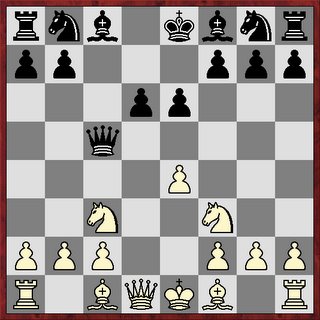
From here I decided to bring out my minor pieces against his Queen.
6.Be3 Qc7 7.Nb5 Qd8 8.Bg5
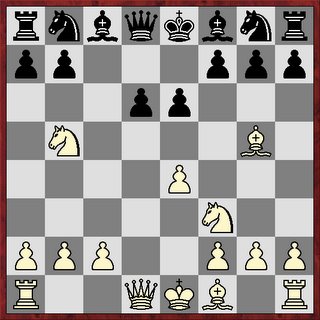
Now look at his position. I have 3 minor pieces out. His pieces on the other hand are all on its initial place. He has still one move to play. It took white 5 moves to obtain this position in shortest amount of tempos. It took for black 2 moves to get his pawns in this position + one extra move still to play, White has an increased lead in development in comparison to the beginning of the game. Black needs 6 moves to complete his development minus 1 coz its his turn to play. White needs 3 moves to complete his development (Bishop, connect rooks and activate Q). A difference of 2 moves. Due to an activation of your minor pieces against his Q, you have built up a massive lead in development. This means that black might become very vulnerable and might be exposed to an early attack from white. And if correct, black will not recover.
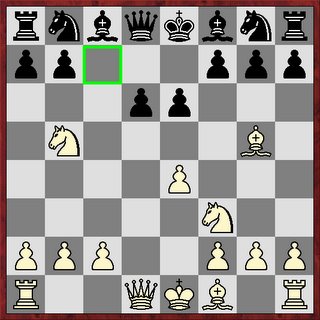
The Black Q is tied to the defense of the square c7.
8. ... Nf6 is not possible due to e5!
8. ... Be7 looses a pawn or looses the right to castle.
Already black have troubles.
8. ... Qb6 [8...Be7 9.Bxe7 Nxe7 10.Nxd6+ Kf8 11.Qd2] 9.a4 a6 10.a5 Qc6
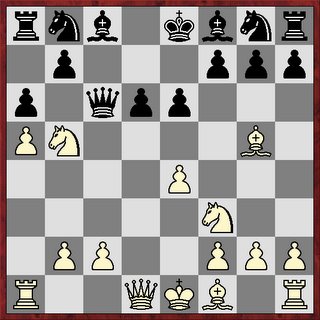
So the question why a4?
I want to trap the Q, or at least harrash her as much as I can without retreating the Knight. Also I saw that I could push the pawn up to a5, taking control over the b6 square which might become an interesting outpost for a knight or a bishop.In the endgame without pieces we have one pawn that holds two.
What I clearly missed was his response with an attack on d4. I saw Qc6 but did not check the consequences. So I calculated 4 ply deep (lol) and was satisfied with the obtained position.
In my logic, another piece move would have lead to a recover for black in his development as the white knight sooner or later is bound to retreat.
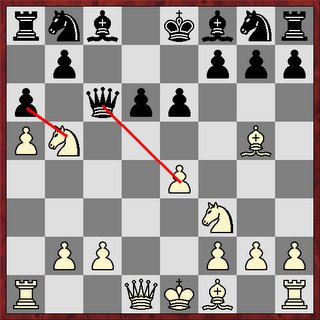
Not defending the d4 square would lead to a loss of the Knight on b5 coz black takes with check. So 2 pieces are hanging. How to defend?
Look if one of the hanging pieces can be move to the defense of the other piece without being captured. Most of the time this will do. So knight goes to c3. With this defensive move without any threat black can take over the initiative, meaning he can force white to react to his moves. Black should do this by boosting his development and if white does react and complies to black's play, black can reduce his lag of development. I know most people define initiative in a different way. By playing Nc3 white gives black actually a free move, a recovering move coz white has no threat following up.
11.Nc3 Be7 12.Bd3 Qc7 13.Be3 Nd7 14.0-0 Ngf6 15.Na4
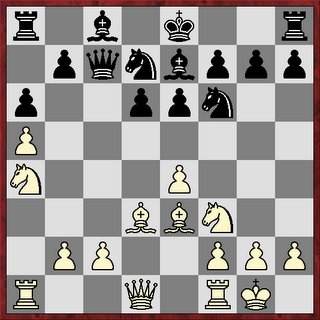
So why not the exchange on Be7?
Black asks for an exchange which would mean that white would trade an active piece for a less active piece. Black would recapture with knight which would boost black's development as he can castled short the next move. By letting him capture Bg5 you can boost your own knight to his Kingside as the knight comes in for a swing.
That's why I played Bd3 (developing move, defensive move d4, freeing Nc3 of the defense of d4). The rest are developing moves.
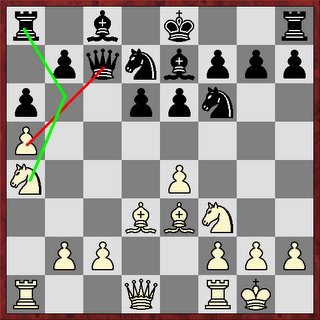
On 15 a4 I went for a little trick. If Qxa5 than Nb6 wins the rook as the Q is attacked. Also It gives my the opportunity to take over the control of the diagonal d8-a5.
15... 0-0 16.Nb6 Nxb6 17.Bxb6 Qd7 18.e5!?
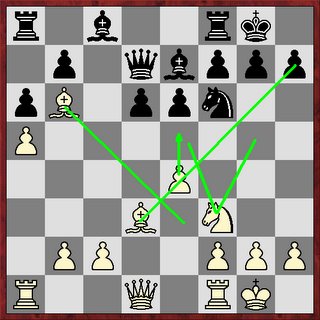
18.e5!? Nd5 19.Bd4! Nb4 20.exd6 Bxd6 21.Bxh7+?!Kxh7 22.Ng5+
With e5 an important defender has been dislodged from the protection of f7. With Nd5 he aims at my light-squared Bishop on d3, the center piece of a possible white's attack on Black's Kingside.
To evaluate the sacrifice one has to calculate all three possible moves of the black king once he accepted the sacrifice. If he has a defense in one of the three variations the sacrifice is dubious which was the case here. The e5 pawn was necessary to protect the f6-flight square. I will not go into details of the greco saccrifice as much literature has been published on this matter. The basic set-up of the pieces is as in the game but with an intact pawn on e5 (which was not the case here). This meant that there was a defense but it was necessary to bring the king in front of his pawns.
But as the bold idiote would say this is hope chess. But where does hope chess starts and where does hope chess ends? When we cannot foresee the outcome? By the evaluation of a position 10 - 20 ply deep? So why than does GM's still loose games. We all play hope chess but we all try to minimize the unpredictable. What seems to be good in 3 ply might sometimes be bad in a 6 ply mode. What might be good in 6 ply might be bad in 12 ply mode etc. So chess becomes hope chess beyond your level of calculation. So my view is you can try to minimize it but it is always present. It never stops.
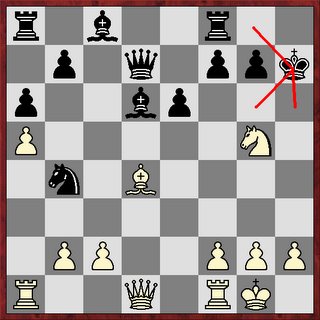
22....Kg8 23.Qh5 Rd8 24.Qh7+ Kf8 25.Qxg7+
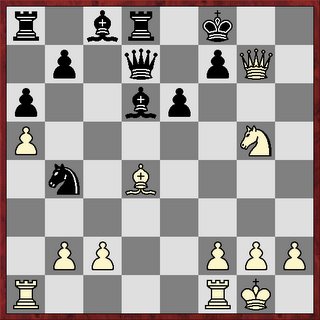
Why didn't I play Qg8+?
In the heat of the battle I didn't found the follow up with Bc5. I only looked to Bg7 and Bf6. So it seemed to me that it was not enough to mate him. I was focused on mating him and was not out on material advantage. With Bc5 it leads to a definite material advantage for white but during the game I missed this move. I did not even consider it, So I played Nh7 with the idea to mate him on the next move (seemed to be the best move then), forgetting of course the Knight on b4. He played Nd5 and here I realized that the simple Nf6 wasn't possible anymore. So push the defender of the f6 square away and therefor I played c4. He played f6, and here I panicked. If black would manage to trade of the Queens he would win the game.It is important afterwards to see this and to behonest with yourself. Due of the fear of loosing I stopped looking for mates but instead started to look for a draw. It was easily found by repetition. Actually there is still a forced mate on the board.
25...Ke8 26.Nh7!? Nd5 27.c4 f6?!28.Qg8+ Ke7 29.Qg7+ ½-½
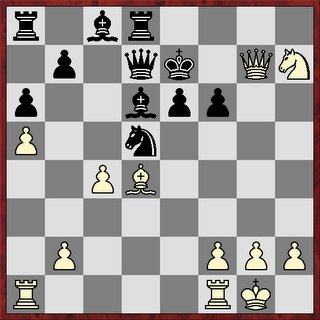
When I went home I was wondering where I made the mistake. If there was not more in the position. I set up the position again and almost immediately I saw the solution. On 29 ... Ke8 30 Qg8+ Ke7 31. Bxf6+!!! Nxf6 32. Qg7+ Ke8 33. Nxf6# (and this is a beauty)
The point is due to the fear of loosing my Q (game over), I could not think clear anymore. I went for the easy outcome. Better was to stretch my legs, go for another beer and walk around a little bit until I was more relaxed.
Did I sleep well that night?
Montse (1513) - H,Sammy (1507) [C00]
1.e4 e6 2.d4 d6 3.Nf3 c5 4.dxc5 Qa5+ 5.Nc3 Qxc5
My opponent starts out as a very passive player and quickly violates (to my experience) the opening principles.

From here I decided to bring out my minor pieces against his Queen.
6.Be3 Qc7 7.Nb5 Qd8 8.Bg5

Now look at his position. I have 3 minor pieces out. His pieces on the other hand are all on its initial place. He has still one move to play. It took white 5 moves to obtain this position in shortest amount of tempos. It took for black 2 moves to get his pawns in this position + one extra move still to play, White has an increased lead in development in comparison to the beginning of the game. Black needs 6 moves to complete his development minus 1 coz its his turn to play. White needs 3 moves to complete his development (Bishop, connect rooks and activate Q). A difference of 2 moves. Due to an activation of your minor pieces against his Q, you have built up a massive lead in development. This means that black might become very vulnerable and might be exposed to an early attack from white. And if correct, black will not recover.

The Black Q is tied to the defense of the square c7.
8. ... Nf6 is not possible due to e5!
8. ... Be7 looses a pawn or looses the right to castle.
Already black have troubles.
8. ... Qb6 [8...Be7 9.Bxe7 Nxe7 10.Nxd6+ Kf8 11.Qd2] 9.a4 a6 10.a5 Qc6

So the question why a4?
I want to trap the Q, or at least harrash her as much as I can without retreating the Knight. Also I saw that I could push the pawn up to a5, taking control over the b6 square which might become an interesting outpost for a knight or a bishop.In the endgame without pieces we have one pawn that holds two.
What I clearly missed was his response with an attack on d4. I saw Qc6 but did not check the consequences. So I calculated 4 ply deep (lol) and was satisfied with the obtained position.
In my logic, another piece move would have lead to a recover for black in his development as the white knight sooner or later is bound to retreat.

Not defending the d4 square would lead to a loss of the Knight on b5 coz black takes with check. So 2 pieces are hanging. How to defend?
Look if one of the hanging pieces can be move to the defense of the other piece without being captured. Most of the time this will do. So knight goes to c3. With this defensive move without any threat black can take over the initiative, meaning he can force white to react to his moves. Black should do this by boosting his development and if white does react and complies to black's play, black can reduce his lag of development. I know most people define initiative in a different way. By playing Nc3 white gives black actually a free move, a recovering move coz white has no threat following up.
11.Nc3 Be7 12.Bd3 Qc7 13.Be3 Nd7 14.0-0 Ngf6 15.Na4

So why not the exchange on Be7?
Black asks for an exchange which would mean that white would trade an active piece for a less active piece. Black would recapture with knight which would boost black's development as he can castled short the next move. By letting him capture Bg5 you can boost your own knight to his Kingside as the knight comes in for a swing.
That's why I played Bd3 (developing move, defensive move d4, freeing Nc3 of the defense of d4). The rest are developing moves.

On 15 a4 I went for a little trick. If Qxa5 than Nb6 wins the rook as the Q is attacked. Also It gives my the opportunity to take over the control of the diagonal d8-a5.
15... 0-0 16.Nb6 Nxb6 17.Bxb6 Qd7 18.e5!?

18.e5!? Nd5 19.Bd4! Nb4 20.exd6 Bxd6 21.Bxh7+?!Kxh7 22.Ng5+
With e5 an important defender has been dislodged from the protection of f7. With Nd5 he aims at my light-squared Bishop on d3, the center piece of a possible white's attack on Black's Kingside.
To evaluate the sacrifice one has to calculate all three possible moves of the black king once he accepted the sacrifice. If he has a defense in one of the three variations the sacrifice is dubious which was the case here. The e5 pawn was necessary to protect the f6-flight square. I will not go into details of the greco saccrifice as much literature has been published on this matter. The basic set-up of the pieces is as in the game but with an intact pawn on e5 (which was not the case here). This meant that there was a defense but it was necessary to bring the king in front of his pawns.
But as the bold idiote would say this is hope chess. But where does hope chess starts and where does hope chess ends? When we cannot foresee the outcome? By the evaluation of a position 10 - 20 ply deep? So why than does GM's still loose games. We all play hope chess but we all try to minimize the unpredictable. What seems to be good in 3 ply might sometimes be bad in a 6 ply mode. What might be good in 6 ply might be bad in 12 ply mode etc. So chess becomes hope chess beyond your level of calculation. So my view is you can try to minimize it but it is always present. It never stops.

22....Kg8 23.Qh5 Rd8 24.Qh7+ Kf8 25.Qxg7+

Why didn't I play Qg8+?
In the heat of the battle I didn't found the follow up with Bc5. I only looked to Bg7 and Bf6. So it seemed to me that it was not enough to mate him. I was focused on mating him and was not out on material advantage. With Bc5 it leads to a definite material advantage for white but during the game I missed this move. I did not even consider it, So I played Nh7 with the idea to mate him on the next move (seemed to be the best move then), forgetting of course the Knight on b4. He played Nd5 and here I realized that the simple Nf6 wasn't possible anymore. So push the defender of the f6 square away and therefor I played c4. He played f6, and here I panicked. If black would manage to trade of the Queens he would win the game.It is important afterwards to see this and to behonest with yourself. Due of the fear of loosing I stopped looking for mates but instead started to look for a draw. It was easily found by repetition. Actually there is still a forced mate on the board.
25...Ke8 26.Nh7!? Nd5 27.c4 f6?!28.Qg8+ Ke7 29.Qg7+ ½-½

When I went home I was wondering where I made the mistake. If there was not more in the position. I set up the position again and almost immediately I saw the solution. On 29 ... Ke8 30 Qg8+ Ke7 31. Bxf6+!!! Nxf6 32. Qg7+ Ke8 33. Nxf6# (and this is a beauty)
The point is due to the fear of loosing my Q (game over), I could not think clear anymore. I went for the easy outcome. Better was to stretch my legs, go for another beer and walk around a little bit until I was more relaxed.
Did I sleep well that night?


3 Comments:
An exciting game! A lot of calculating during the first part of the game can cost you so much energy that your calculation skills decline. I often noticed that myself. Was that the case here?
very nicely annotated and displayed on your website!
Tempo,
I had time enough left on the clock so this can not be issue.I learned not to calculate too much in the beginning of the game (first 5-6 moves)but just watch the board what is happening.
I am afraid I could not think clear (too much anxiety). Was I exhausted - to be honest I don't think so. Maybe the pressure was too large as a lot of people were watching the game. This seems to be more a psychological barrier, something that I have to be more aware of in the future.
Post a Comment
<< Home